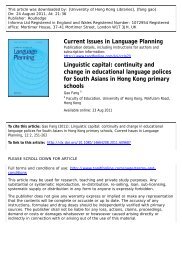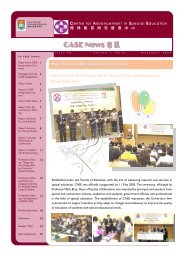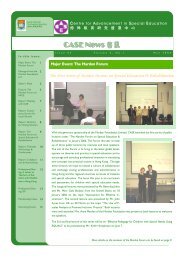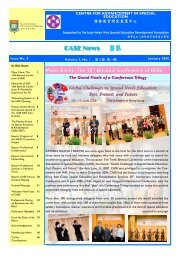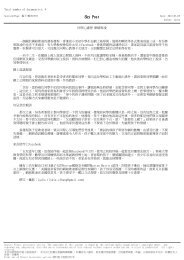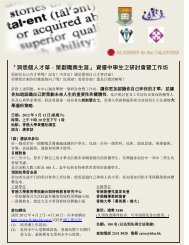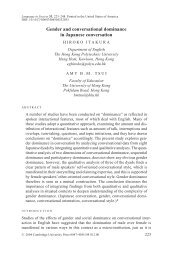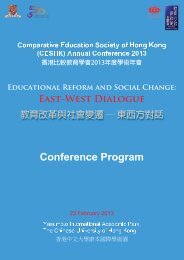Comparative Education Bulletin - Faculty of Education - The ...
Comparative Education Bulletin - Faculty of Education - The ...
Comparative Education Bulletin - Faculty of Education - The ...
Create successful ePaper yourself
Turn your PDF publications into a flip-book with our unique Google optimized e-Paper software.
<strong>The</strong> Historical Evolution <strong>of</strong> the Teaching <strong>of</strong> <strong>Comparative</strong><br />
<strong>Education</strong> at Universities Internationally<br />
C.C. Wolhuter, North-West University<br />
N. Popov, S<strong>of</strong>ia University<br />
M. Manzon, <strong>The</strong> University <strong>of</strong> Hong Kong<br />
B. Leutwyler, Institute for International Cooperation in <strong>Education</strong><br />
<strong>The</strong> aim <strong>of</strong> this article is to investigate the historical evolution <strong>of</strong> <strong>Comparative</strong><br />
<strong>Education</strong> at universities worldwide, as a basis for a critical reflection on<br />
its future prospects. Each <strong>of</strong> the following phases is discussed: a Prehistoric<br />
Phase; Phase I: Early years, 1900s and 1910s; Phase II: Classic years, 1920s<br />
and 1930s; Phase III: Expansion (Western and developing countries) vs.<br />
Constriction (East Block), 1950s to mid-1970s; Phase IV: Contraction (Western<br />
Europe and North America) vs. Revitalisation (Greece, Eastern Europe and<br />
China), mid-1970s to 1990s; and Phase V: Proliferation: 2000s. In conclusion<br />
a fourfold strategy for securing and extending <strong>Comparative</strong> <strong>Education</strong>’s place<br />
in universities is recommended: utilizing the field’s excellent international<br />
organizational networks; holding onto its place in universities where such<br />
exist; placing on the <strong>Comparative</strong> <strong>Education</strong> research agenda themes directly<br />
and visibly relevant for teachers and for teacher education; and articulation<br />
<strong>of</strong> <strong>Comparative</strong> <strong>Education</strong>’s significance, at grassroots and at policy-making<br />
levels.<br />
Introduction<br />
<strong>Comparative</strong> <strong>Education</strong> has for slightly over a century figured across<br />
the world in teacher education programmes, and therefore enjoyed<br />
a presence at universities. With the content and focus <strong>of</strong> teacher education<br />
programmes currently especially topical, a stock-taking <strong>of</strong> and a<br />
critical reflection on the place <strong>of</strong> <strong>Comparative</strong> <strong>Education</strong> at universities<br />
is apt. <strong>The</strong> aim <strong>of</strong> this article is to describe the historical evolution <strong>of</strong><br />
<strong>Comparative</strong> <strong>Education</strong> at universities worldwide, as a basis for a critical<br />
reflection on its future prospects.<br />
Having studied the historical evolution <strong>of</strong> <strong>Comparative</strong> <strong>Education</strong><br />
at universities, the authors describe this history in terms <strong>of</strong> five phases,<br />
preceded by a pre-historic phase, each <strong>of</strong> which will be discussed:<br />
- Phase I: Early years, 1900s - 1910s<br />
- Phase II: Classic years, 1920s - 1930s;<br />
- Phase III: Expansion vs. Constriction, 1950s to mid-1970s;<br />
- Phase IV: Contraction vs. Revitalisation, mid-1970s - 1990s;<br />
- Phase V: Proliferation: 2000s.<br />
3



